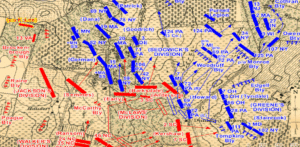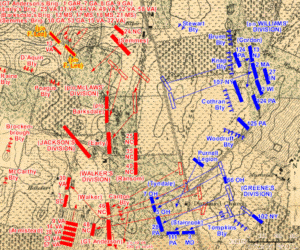Confederate Leadership at Sharpsburg: Left Flank, 9:00 a.m – 1:00 p.m, Part 2
West Woods, Dunker Church, and Hagerstown Pike
The morning fighting had shattered several Confederate commands. Starke’s and Lawton’s divisions had been badly mauled. Hood’s regiments had been wrecked for the time being. These three divisions, though, had taken out one of the toughest Union corps: I Corps. Now, a division from II Corps and the entire XII Corps’ headed toward the gap in the left flank to deliver the coup de grace, but the Confederates were still in the fight. The focus now shifted to the West Woods, Hagerstown Pike, and the Dunker Church plateau.
General Lee and his officers rushed troops to Maj. Gen. Thomas Jackson’s aid. Lee’s staff officer, Maj. Walter Taylor, got Maj. Gen. Layfette McLaws’ division moving by the quick step. Another staff officer from Jackson’s command found Maj. Gen. James Longstreet and asked if he could spare some troops. Longstreet sent Brig. Gen. John G. Walker’s division post haste.[1]
Stonewall knew two divisions wouldn’t be enough. His only intact command was Brig. Gen. Jubal Early’s brigade already bruised from the initial morning fight. Early had returned and deployed his soldiers near the West Woods, reporting his observations to Jackson. More reinforcements were needed. “The danger was imminent.”[2] Jackson regrouped his battered regiments and reformed his old division and waited for more reinforcements.
McLaws arrived first ahead of his men and gathered information from officers who had been in the early morning fight and were familiar with the topography. He first met with Jackson. It’s unknown what was said, but Jackson then referred McLaws to Hood. The big Kentuckian told McLaws that part of his division had been pushed out of the West Woods, and the enemy was now advancing through it with a large force. Hood also described the terrain and suggested which direction McLaws’ brigades (Semmes, Barksdale, and Kershaw) should spearhead their attack.[3]
Skill and chance allowed 3,875 Confederates to stop the advance of Maj. Gen. John Sedgwick’s 6,050 strong 2nd Division of II Corps in the West Woods. Brigadier General Paul Semmes’ brigade and some of Jackson’s makeshift battalion blasted their opponent point blank from the front. Simultaneously, Early’s, Brig. Gen. William Barksdale’s, Brig. Gen. G. T. Anderson’s brigades with the 3rd South Carolina smashed into the enemy’s vulnerable left flank. Hit from two-sides, the blue-clad troops crumbled back onto the Union regiments behind them.[4]

Chaos erupted in the West Woods. Jackson recalled: “the whole now united, charged upon the enemy, checking his advance, then [drove] him back with great slaughter entirely from and beyond the wood, and [gained] possession of our original position.” [5] On the Union side, Roland Bowen of the 15th Massachusetts, remembered their withdrawal.
“All hands ran for dear life. I pulled to the left to get out of the range of the guns and got off safe and sound. The rebs chased us like the Devil for about a half or 3/4 of a mile when our batteries opened on them with grape and they give up the chase….No God Damned Southerner is going to catch me unless he can run 29 miles an hour. That’s my gate.”[6]
In less than 15 minutes, Sedgwick’s division collapsed; thirteen or so regiments were on the run. Other Union soldiers lie dead or writhing in pain.
Up on the Dunker Church ridge and Hagerstown Pike, the Confederates took on two other Union divisions from the XII Corps. Part of Kershaw’s brigade and Walker’s division thwarted and broke the oncoming enemy regiments. Kershaw’s South Carolina boys charged after the withdrawing Union ranks only to be cut down by superb artillery and infantry. “We were confronted with artillery and any numbers of lines of infantry that belched forth such destruction as I had never seen before,” Capt. Henry W. Addison, Co. H, 7th South Carolina, later wrote.[7] Kershaw’s regiments retreated and redeployed behind the Dunker Church.

It was around 10:30 a.m. “No further advance, beyond demonstrations, was made by the enemy on the left.”[8] The dead, dying, and wounded lay everywhere. In the West Woods, Confederates counted over 2,000; Union suffered over 2,200 casualties.[9] Casualties on the Dunker Church plateau amounted to Confederates, 1,258 and Union, 1,728. The day’s violence, however, was far from over. Just south, artillery and infantry fire rang out all along Lee’s center.
[1] McLaws’ official report https://antietam.aotw.org/exhibit.php?exhibit_id=36. Paul Semmes’ brigade of McLaws’ division was the first to arrive. Taylor couldn’t find McLaws. The general had fallen asleep in some tall grass. Hartwig, I Dread the Thought of the Place: The Battle of Antietam and the End of the Maryland Campaign, 220. Maps are taken from https://antietam.aotw.org.
[2] Early’s official report, https://antietam.aotw.org/exhibit.php?exhibit_id=37.
[3] Hartwig, 239.
[4] Hartwig, 256. Breakdown in Confederate strength: Early, less than 1,100; Jackson’s makeshift battalion, maybe 500; Paul Semmes, 787 and William Barksdale, 891; G. T. Anderson, 597. Strengths and Casualties – Army of Northern Virginia, Appendix in Hartwig.
[5] Jackson’s official report https://antietam.aotw.org/exhibit.php?exhibit_id=41. Col. Andrew Jackson Grigsby replaced Starke and took charge of the Stonewall division. This command participated in the final push that ended the fighting on the left flank. There’s a side story about Grigsby. If you’d like to read about it see https://antietam.aotw.org/officers.php?officer_id=906&from=results.
[6] Marion Armstrong, Unfurl Those Colors! McClellan, Sumner, & The Second Army Corps in the Antietam. Tuscaloosa: University of Alabama Press, 2008. https://jarosebrock.wordpress.com/maryland-campaign/antietam/the-west-woods.
[7] Hartwig, 278.
[8] Jackson’s official report https://antietam.aotw.org/exhibit.php?exhibit_id=41.
[9] https://www.nps.gov/anti/learn/historyculture/casualties.htm.
This is an excellent series! Very informative
Informative and told in thrilling fashion. Looking forward to the future installments.